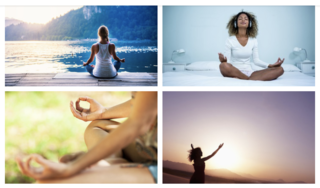Meditation
Meditation and Technology: Why It Just Got Better
A new app allows you to join a live, group meditation class from anywhere.
Posted May 13, 2019

Meditation, whose roots can be traced back nearly 3,000 years, is finally having its moment—and gently moving into the mainstream. A nationwide survey conducted by the National Institute of Health revealed that the number of adults who practice meditation increased more than threefold—from 4.1 percent in 2012 to 14.2 percent in 2017.
Adding to the boost in meditation’s popularity is the marriage between meditation and smartphone technology, which took place nearly ten years ago. Since then, a growing number of apps, such as Headspace, Insight Timer, and Calm, have been bringing a wide variety of guided meditations to the masses. With the touch of a finger, you can enjoy minutes, or hours, of serenity—in the form of a recorded voice—as you go about your busy life, at home or work, while commuting or traveling.
But what if you want to meditate with others, from near or far, as part of a community? Often thought of as a solitary experience, meditation is widely practiced in groups and many meditators speak about the power of practicing with others. “Meditators in groups often report that they feel less alone and more connected to others," writes Deepak Chopra, author of several books on alternative medicine. "Their practice feels deeper, tapping into a more profound silence than they experience on their own.”
There's been a rise of meditation studios cropping up in larger cities, such as MNDFL in New York and Unplug in Los Angeles, where people come together to meditate. So imagine that you can have a group meditation experience live streaming on your smartphone—meditating simultaneously with others with guidance from a supportive teacher and an opportunity to pose questions and share your experience with fellow meditators—from wherever you are.
A new app, Journey LIVE is making this experience a reality. Designed to mirror in-person meditation classes, it is the first ever tech-enabled, real-time meditation experience—think the Peloton of meditation. The 15-minute classes are offered throughout the day and evening, with a daily recorded class is offered in case one of the set classes doesn’t suit your schedule.
"I've seen the magic that happens when you get people together to meditate in a group," says founder and CEO, Stephen Sokoler. "Using an app can feel lonely and isolating. It all changes when you have a live teacher."
As you “enter” the live-stream class, your username pops up on the screen with a waving hand emoji, as do the names of other students also joining. There may be a prompt on the screen, such as “What’s one thing you're grateful for?” to answer in the chat box while waiting for the class to begin. Many of the classes begin with the teacher—basically sitting in his or her living room—welcoming students, calling out a few names (“Welcome, Caren, from New York!”).
"The idea is for us to provide a diverse group of hand selected teachers, with different teaching styles and backgrounds, so you can find someone whose story resonates with you," says Sokoler. "We're building the world's largest, most inclusive community on line."
The Journey LIVE technology is one directional, so you can see the teacher (they can't see you) and theirs is the only voice you'll hear. After being guided through a mindfulness meditation—some classes may add a focus on a specific topic, such as intention or emotions—you are invited to share comments about your practice, or ask questions by typing them into the chat box. The teacher then responds, continuing the live discussion for anyone who wants to stick around once the meditation part is over.
The benefits of meditation are well documented, with research confirming that meditation improves your physical health (lowering high blood pressure and easing chronic pain, for example), as well as your mental health, reducing stress and anxiety. It is no secret that stress is rampant and continuing to grow in the United States—a recent Gallup poll showed that about 8 in 10 Americans say they frequently (44%) or sometimes (35%) encounter stress in their daily lives. Just 17% say they rarely feel stressed, while 4% say they never do.
In reaction to widespread stress levels, the practices of meditation and yoga, are increasing as copings methods, according to the National Institute of Health. Accessing these practices in real-time from anywhere is one of the biggest benefits to emerge from this marriage of meditation and technology. Yogis have been fortunate to practice asanas, or poses, in digital, live yoga classes for some time. And now, there’s one for meditators too. I may not actually see you there, but I’ll be breathing right along with you.


